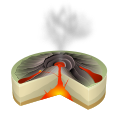Gardner Pinnacles
[2][a] The Gardner Pinnacles were used as an emergency helicopter landing spot for the Hawaiian HIRAN project, an effort to determine the locations of area islands with great precision for navigational purposes.
[2][d] According to a 2020 report in Earth and Planetary Science Letters, Pūhāhonu contains approximately 150,000 cubic kilometres (36,000 cu mi) of rock, based on a 2014 sonar survey.
Only about one-third of that volume is exposed above the sea floor while the rest is buried beneath a ring of debris, broken coral, and other material that has eroded from the peak.
By comparison, from sea floor to peak, Mauna Kea, on Hawaii's Big Island, is the tallest shield volcano on Earth, but it is nowhere near as massive as Pūhāhonu.
[2][e] Pūhāhonu is so heavy, researchers note, that it has caused Earth's crust nearby—and thus the volcano itself—to sink hundreds of meters over millions of years.
[2][c] The five seamounts of the Naifeh Chain to the north of Pūhāhonu have a completely different tectonic origin, and are older (Late Cretaceous).
[12] In the surrounding waters there is a variety of sealife, which is noted as habitat for a limpet, the giant ophi which lives in tidal areas of the rocky island.
[6] Some of the fish species in the nearby waters include red lip parrotfish, doublebar goatfish, and reef triggerfish.






